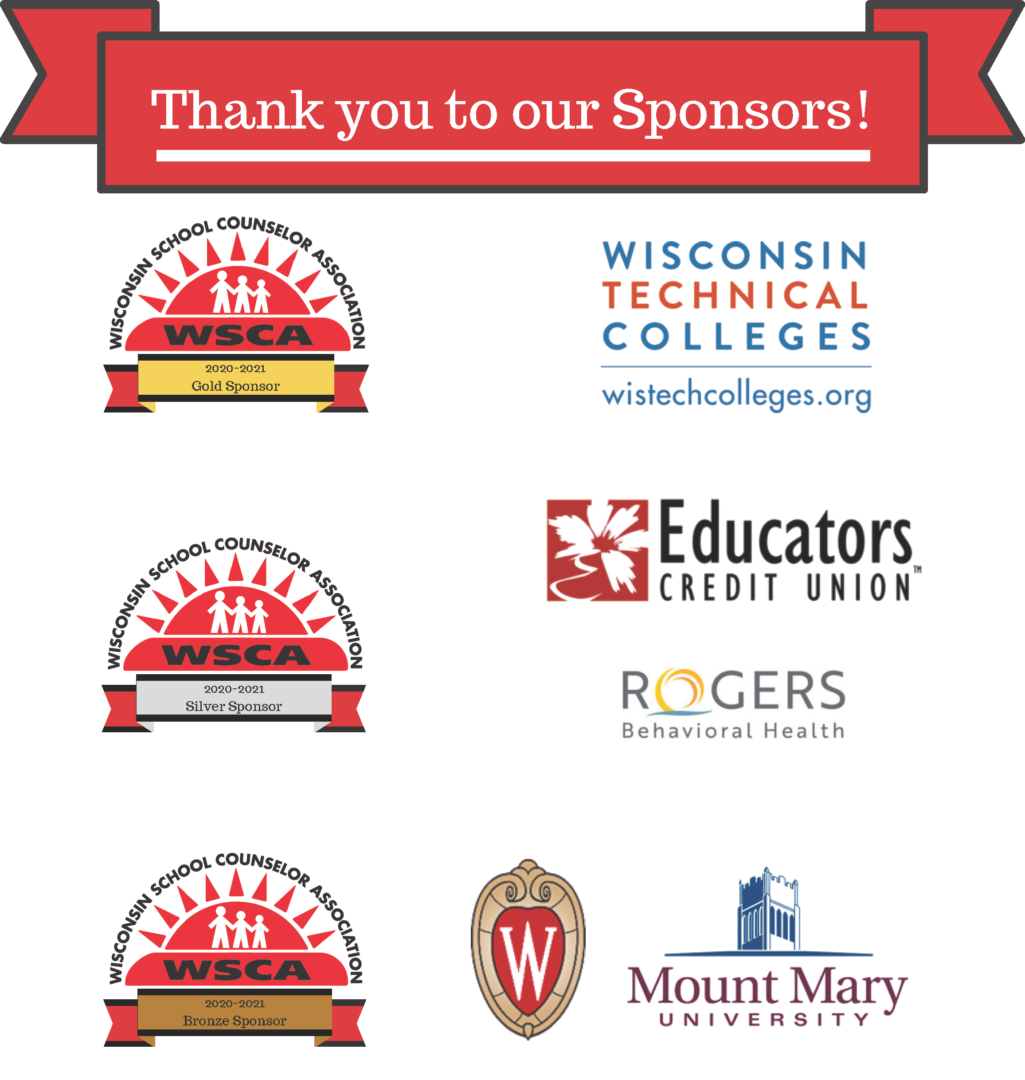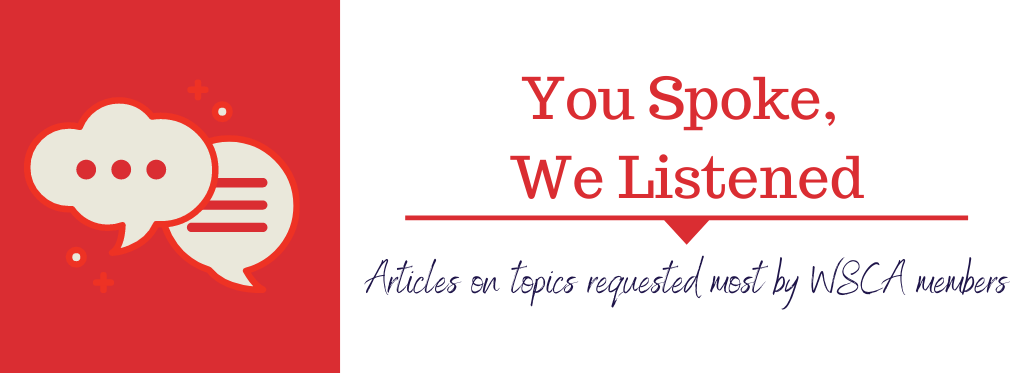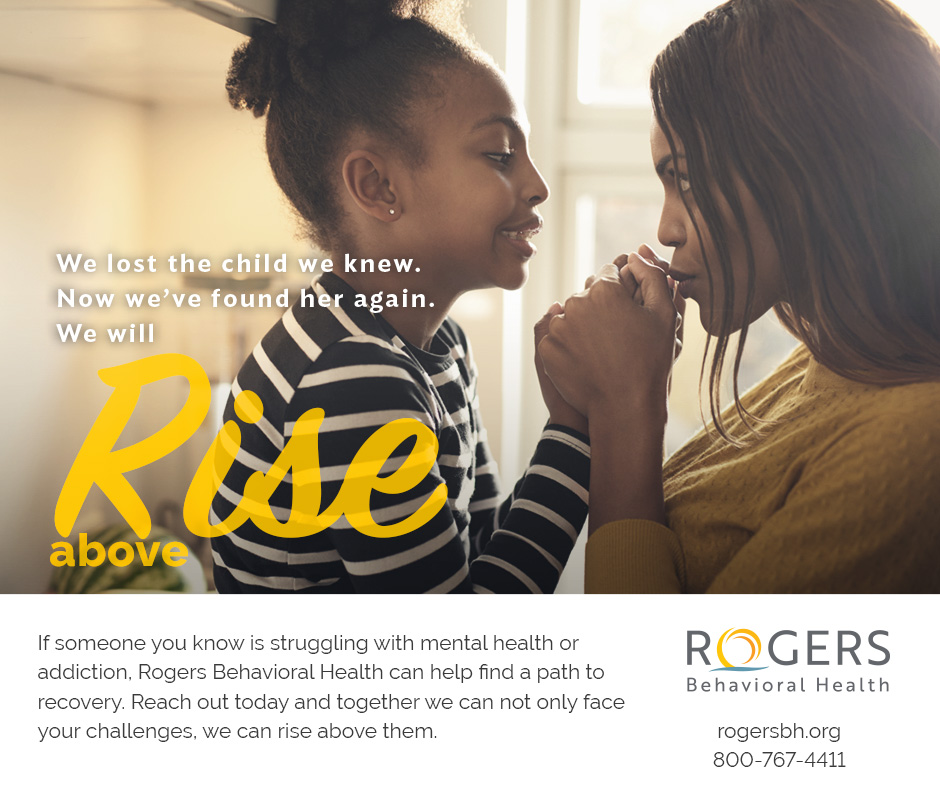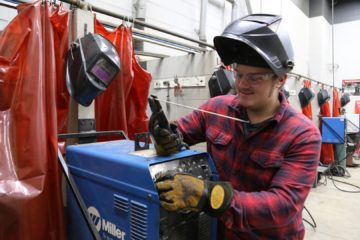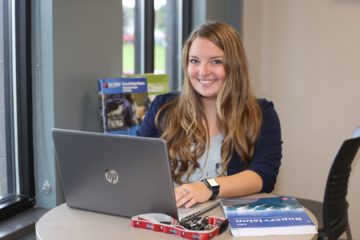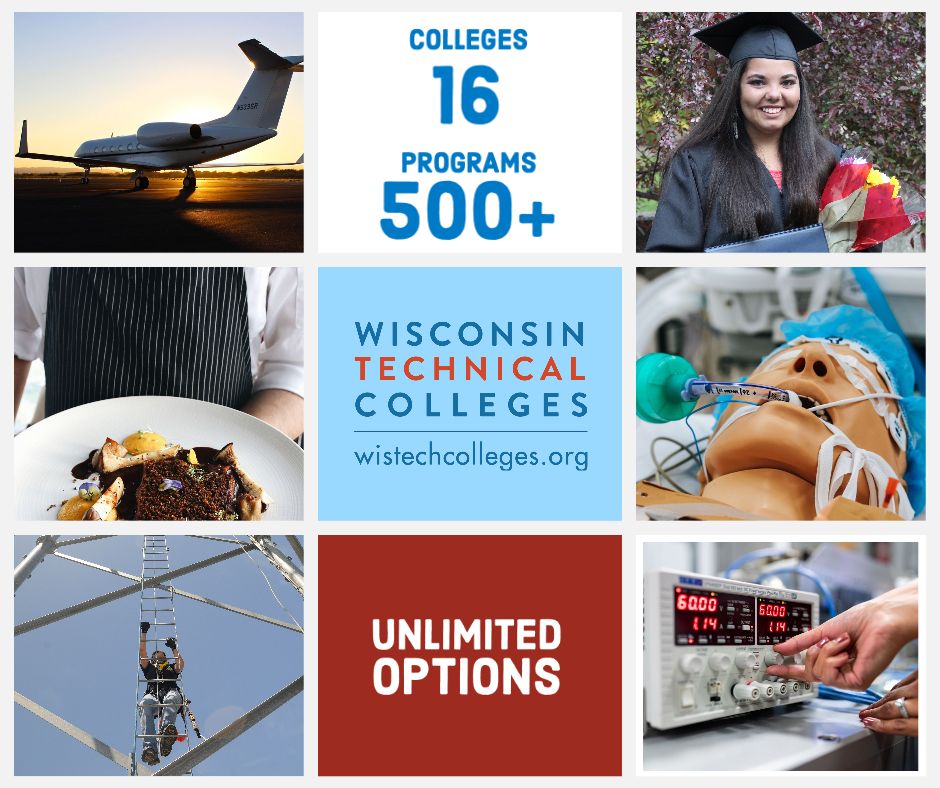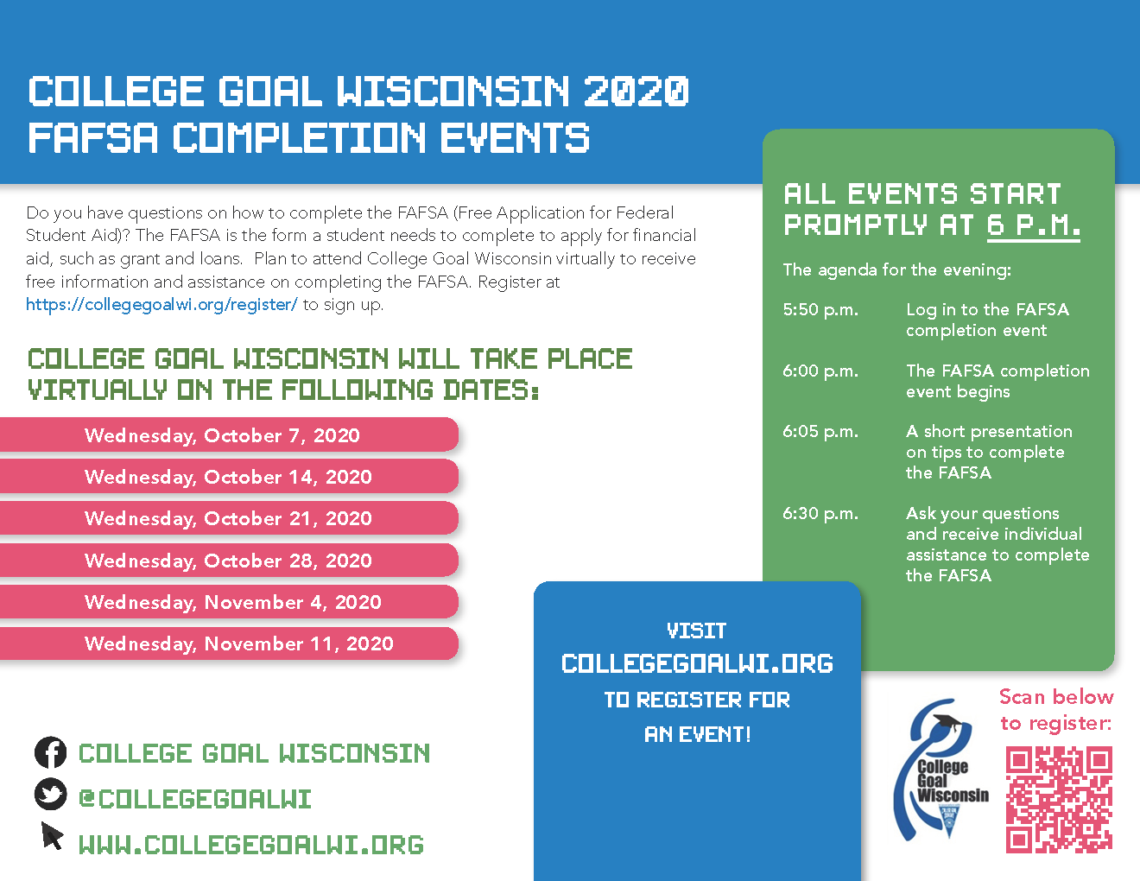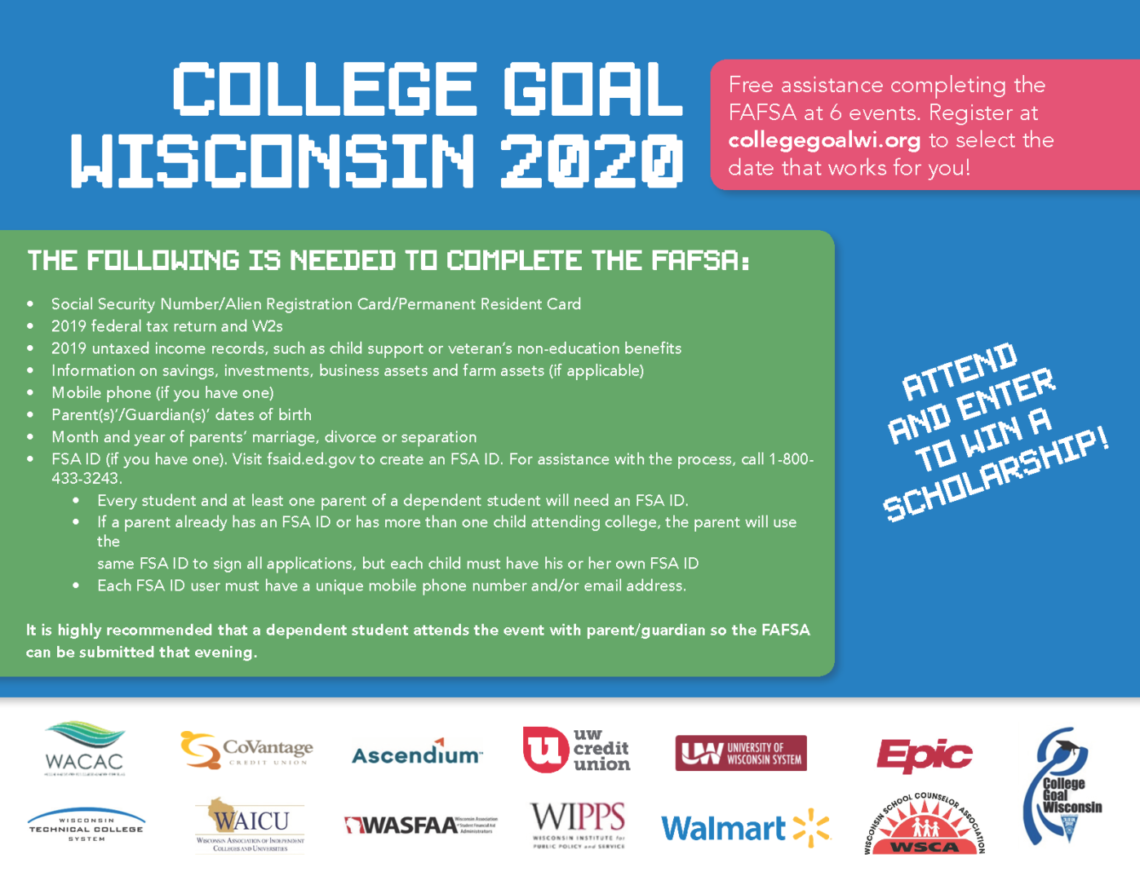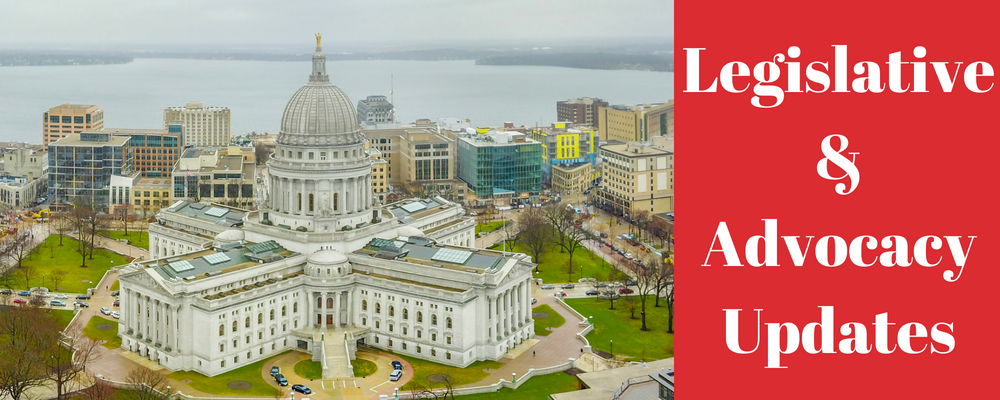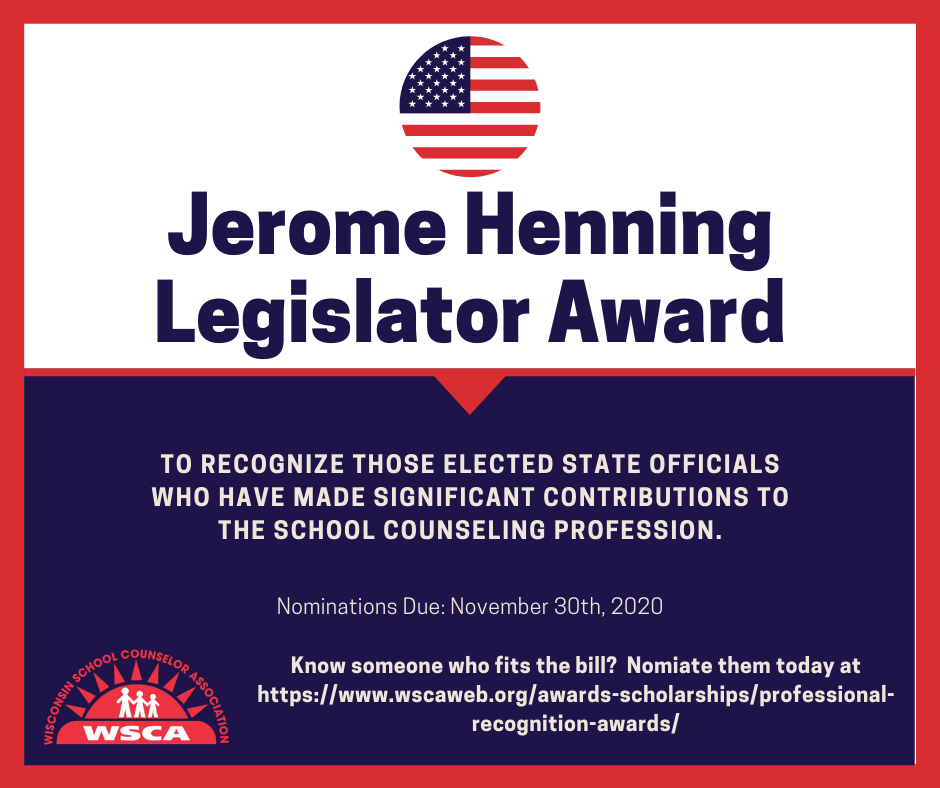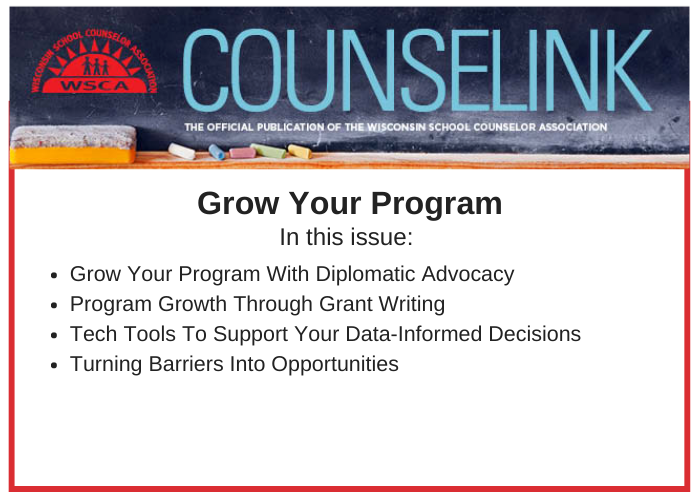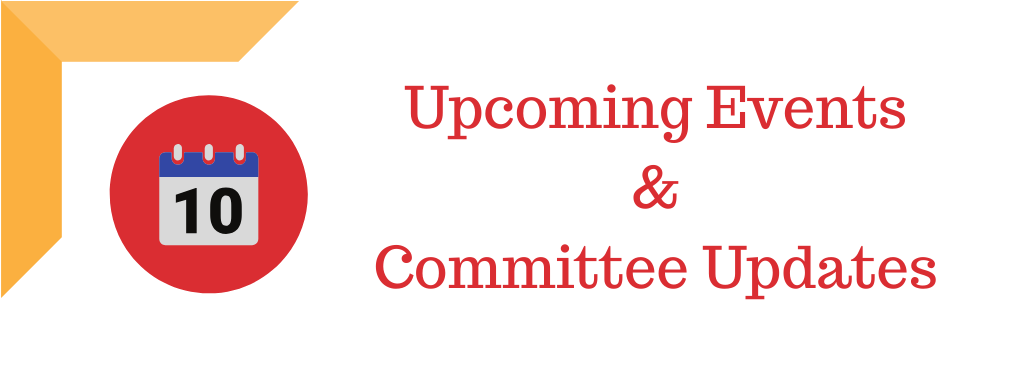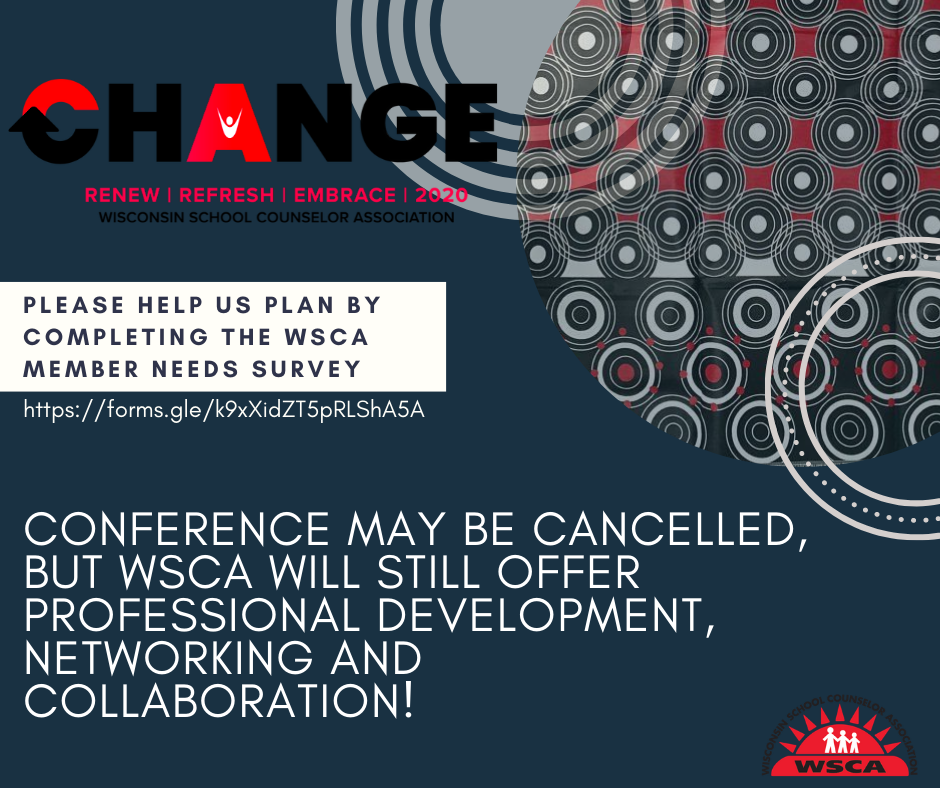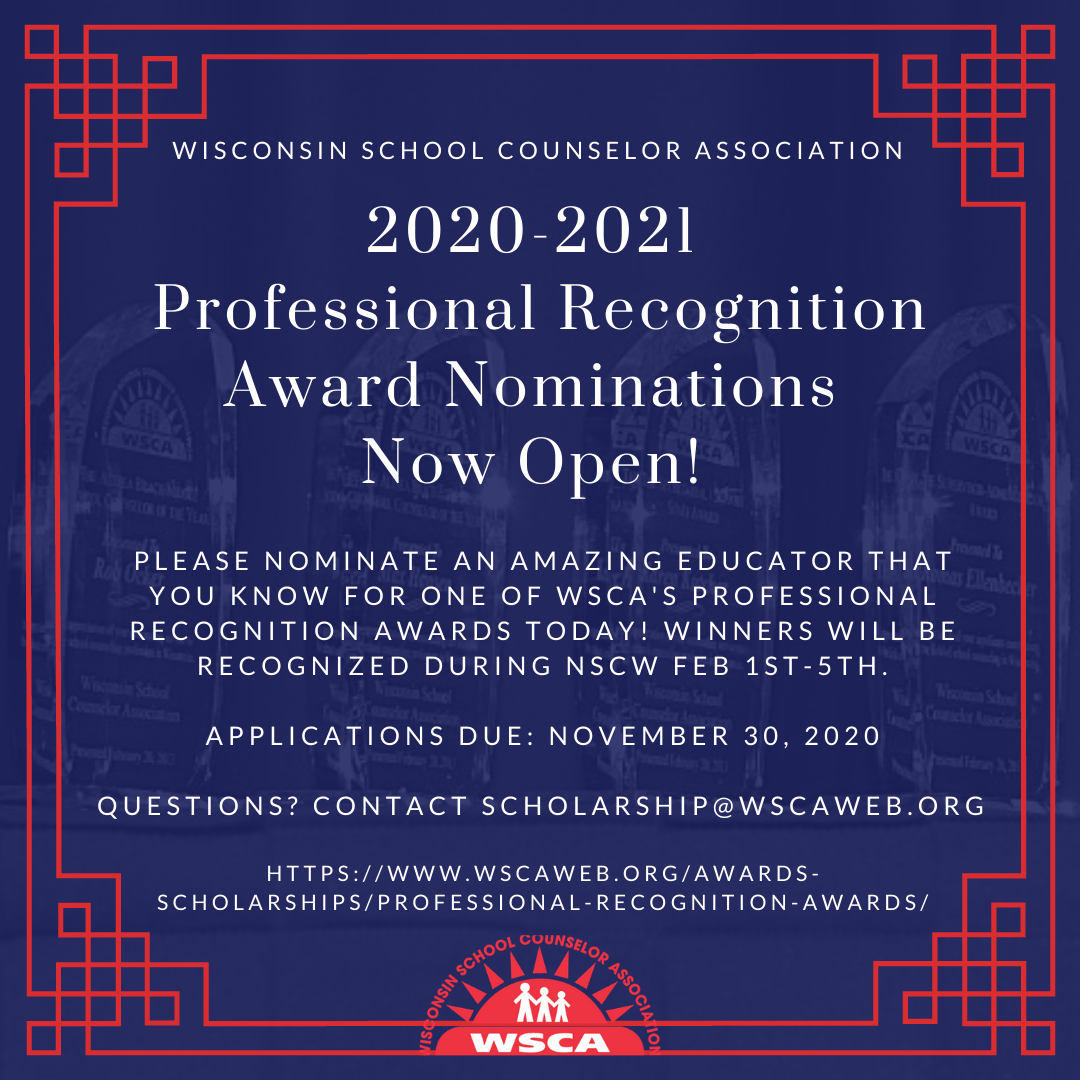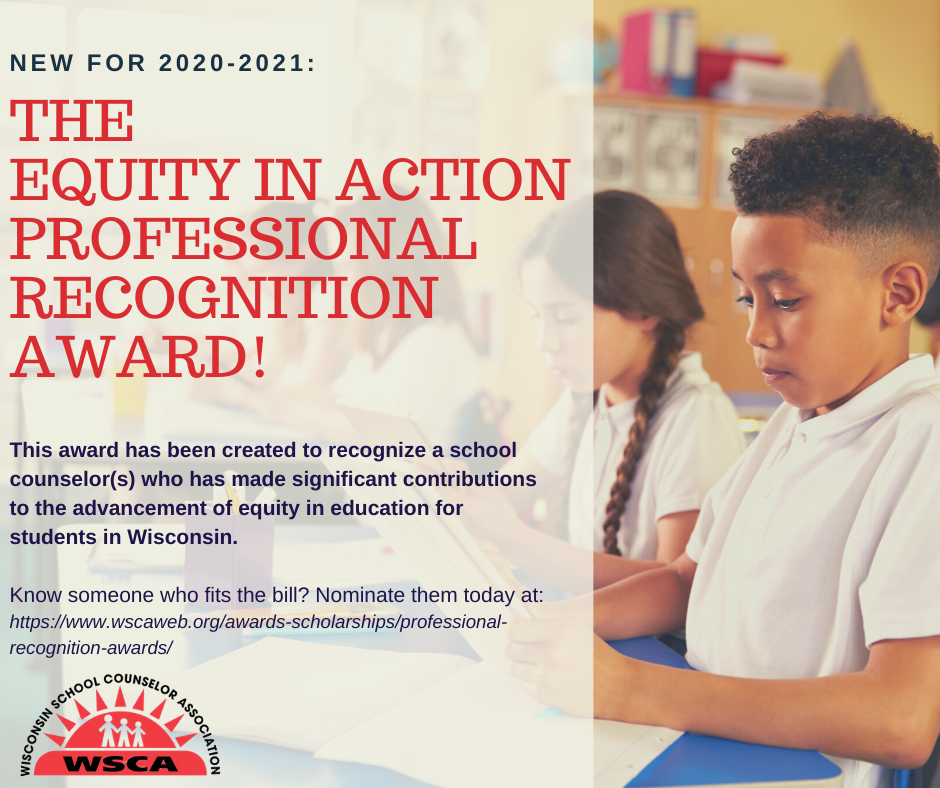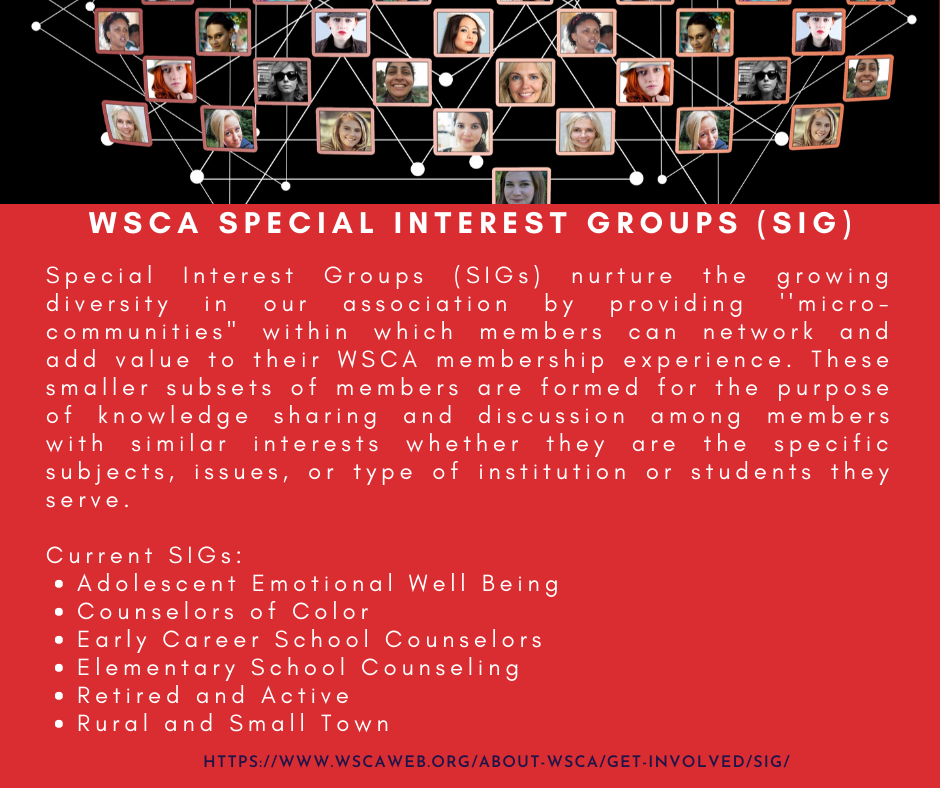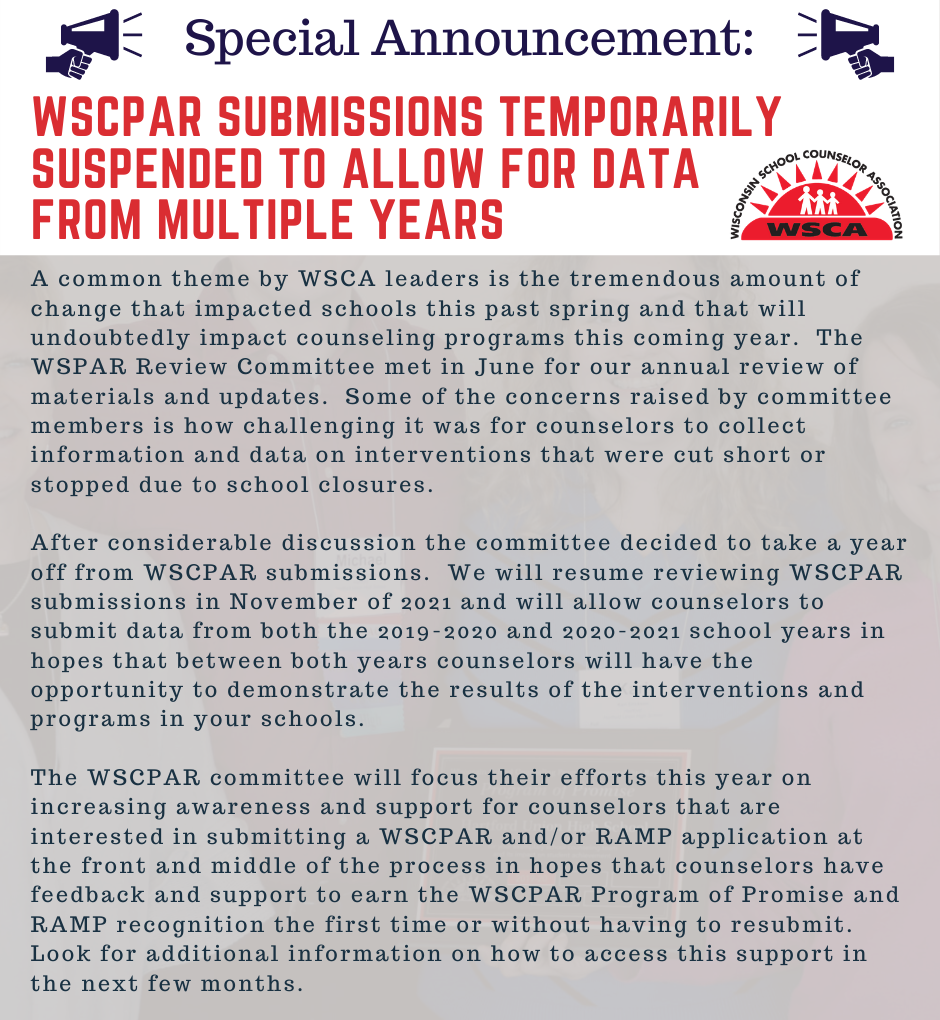September 2020

In This Issue:
- A Message from the Executive Director
- A Message from the Board of Directors
- Thank you to our Sponsors!
- Feature Article – Grow Your Program with the Annual Agreement!
- You Spoke, We Listened – Social-Emotional Well-Being: Socialization Impacts Children and Teens
- Equity & Social Justice: Eliminating Racism and Bias in Schools: The School Counselor’s Role
- College & Career Readiness: Students Need Academic and Career Planning More Than Ever: ACP Updates and Resources
- College & Career Readiness: College Credit for High School Students
- College Goal Wisconsin 2020
- Legislative Update – DPI Proposed Changes to PI 34 Update
- Jerome Henning Legislator Award
- Counselink Fall 2020
- Upcoming Events & Committee Updates – Member Online Learning Needs Survey
- Professional Recognition Nominations Open
- New Award: Equity in Action
- Special Interest Groups
- WSCPAR Temporarily Suspended
- WSCA Committees Need YOU!
Stacy Eslick, WSCA Executive Director
Dear WSCA members,
For those of you who know me well I am not often at a loss for words, yet this welcome message has been one of the most challenging for me to write. What is there is to say that will make counseling any easier in the middle of a pandemic, as well as the midst of a much needed racial justice uprising, topped off with one of the most polarizing presidential elections in recent history? As I listen to counselors from across the state I am in awe of their resilience, perseverance and dedication to their students, families, and communities.
What I want all our members to know:
WSCA staff and leaders care deeply about not just the profession but each and every one of you. We are working hard to use member voice and input in all we do so we can best support you so you can best support your students.
Our hearts were breaking for Jacob Blake’s family and the entire Kenosha community. WSCA is committed to racial equity and taking steps to put equity at the forefront of our work.
Wisconsinites, especially school counselors are a strong group. While we are strong, it is also ok to be vulnerable. We all only have so much to give before our bodies start screaming at us that enough is enough. Give yourself permission to say this is good enough.
This will be a school year like no other, however, COVID will not last forever. While we often say that we should give others grace during this time, are you doing the same for yourself? My mantra is “How do we get through this year as safely and humanely as possible?”.
When working in schools I used to have my students create acrostics to reinforce skills learned in my lessons. Below is my acrostic for this year.
WSCA is here for you
Self-care is a thing
COVID will not last forever
Accept that we are all doing the best we can~Stacy Eslick
Miriam Brown, Board Member
School Counselor, Sugar Creek ElementaryThese are tough times; terrible times. When we met as a Board in July, our conversations were equally tough: police murder of brown and black folx, the insidious way racism is omnipresent in all our institutions, and the manner in which we, as well-meaning (mostly white) School Counselors are complicit in this racist system.
We enter this profession because we want to help, support, and guide. In this way, it can be difficult emotionally the first time we are confronted with the reality that our racialized identity as well-meaning (mostly) white women actively harms the academic and emotional success of our BIPOC students. For me, there was a moment of grief as I realized that even my best intentions would not be enough to ensure the success of all my students if I did not engage in work to unlearn many things.
But we can choose how to handle this grief. We can choose how to mourn the loss of this illusion. Because it is an illusion; a myth that all we need to do to support our BIPOC students is have good intentions. Because good intentions still lead to microaggressions; good intentions contribute to disproportionate discipline rates; good intentions lead to the status quo being perpetuated. And good intentions allow us to exempt ourselves from the responsibility of dismantling the system that has for years failed brown, black, latinx, LGBTQ+, and differently abled folx.
It’s important to surround yourself with professionals who will support you in this journey. And those professionals need to be different from you, because we cannot understand these issues fully without the experience of BIPOC in our profession. But us white folx should not rely on BIPOC (and I have been guilty of this!) to do all the emotional labor for us. We need to be present and supportive of each other on our journeys and we need to listen and honor their voices. The amazing thing about this profession is that we have a community of people who come from different backgrounds and yet we all have the same goal. Our shared goal as school counselors is the well-being and success of all our students. Let’s use this shared goal to give us the strength to sit in discomfort and hear hard truths and face tough realities.”
As a professional community we have each other and a shared goal. Read books like White Fragility, follow BIPOC authors and activists on social media, amplify their voices. Whatever your school year looks like, take intentional time to reflect on your practice and be humble and honest about potential failures. Re-envision the system. It’s normal to feel grief and discomfort as a white person confronting these truths, but just like I had the Board to support me through that, we have each other as a professional family. Reach out, we are here for those conversations!
~Miriam Brown
Grow Your Program with the Annual Agreement!
Sarah Flier, School Counselor, Willow River Elementary
WSCA 2019-2020 School Counselor of the YearThe Annual Agreement template from ASCA can be a fantastic way to grow your program. It lays out the plan for your school year and organizes components of a comprehensive program that benefits all of our students. While this year will look unlike any other year we’ve had, this template can help ground your program!
The template asks for your mission statement, goals, the percent of time you spend with indirect and direct services, your advisory committee plans, professional development you hope to obtain during the year, basic budget information, caseload, the committees you are involved in at your school and what your office hours will look like.
With Educator Effectiveness, we are all creating annual goals – don’t reinvent the wheel! This same goal can be a program goal on your annual agreement and will help target your efforts throughout the year. Start with this goal and add another the following year. Don’t have an advisory committee? Maybe this is the year to research why they can help improve your program and how to get started – or even try it out! With so many of our meetings going virtual, you might be able to get even more community participation. Not sure what percentage of hours spent doing direct services vs. indirect? Maybe this is the year to track your tasks for a few weeks to get an idea of where you’re spending your time! Network with other counselors throughout our state and find out how they have added this into their program and what benefits they have seen in their programs. Once you start slowly chipping away at the items on the annual agreement, you’ll feel far more confident in the document and see how each component can help your program grow!
The annual agreement is also a great conversation starter for you and your principal as you begin your year – even school years like this where there is so much uncertainty. This template from ASCA can help administrators further understand your program and build collaboration and support for the work you do. New principals or well-versed principals can still learn more about our roles, what we can do for students and all of the hats we wear throughout the year!
For those interested in submitting a Wisconsin School Counseling Accountability Report (WSCPAR) in the fall of 2021, this is one of the documents we are encouraging school counselors to try to complete as much as possible. The agreement is also not set in stone, and can be altered during the year – given the changes we will be experiencing this year, it is understandable if goals are shifted, professional development changes and best laid plans aren’t possible. We encourage you to try it out this year and set aside time to have the conversation with your administrator this fall. If you have any further questions, please do not hesitate to contact Stacey Miller or Sarah Flier at data@wscaweb.org for further information and support. We can’t wait to see how the annual agreement helps your program grow!
Socialization Impacts Children and Teens
Rogers Behavioral HealthAs social distancing guidelines are being implemented across almost every facet of our lives, we know that continued physical isolation can take a toll on the mental health of both adults and children. Socialization is essential to everyone’s health and well-being, but it is especially important for children to learn the unwritten norms of social interaction.
Socialization during a new kind of school year
Schools are a great way for kids to learn how to communicate, make friends, develop healthy relationships, and get along with people who are different from them. However, as some students across the nation return to school in person this fall, the classrooms they walk into will not be the same as they were last year with face mask requirements, assigned seating at lunch, no sharing of school supplies, and staggered recesses. That means a severely decreased amount of socialization than “normal.”
“Many children may feel frustrated about why there is so much less time they’re able to see a friend during the school day than they’re used to,” explains Dr. Jerry Halverson, Rogers’ chief medical officer. “And on the flip side, many will struggle with how to socialize again when they’re back in a face-to-face setting after months of virtual-only connections. Then there are also many students who are going back to school virtually with no face-to-face instruction who will be confronting the continued isolation from their peers.”
Considering all of these scenarios, Dr. Halverson says it’s important for parents to encourage socialization in the best ways they can for their children given the circumstances, whether that means play dates or hangouts outside appropriately distanced, or connecting via screen time with friends through text or on a group video call.
“Maintaining relationships for students in this pandemic can be critical in creating structure during a time that is extremely abnormal and difficult for many students to process,” he adds.
Is your child suffering from lack of socialization?
There are some common symptoms parents should watch for that could signal a student is having a tough time managing their emotions around the varying socialization expectations the pandemic has spurred.
- Mood swings. If your child seems more irritable or “grouchy” than usual, that could be a sign they’re having a tough time sorting out how they feel, even if they don’t realize it.
- Withdrawing from loved ones. Is your child secluding to the bedroom more and more and communicating with you less and less? This can be a typical part of adolescence, but if it’s unusual for your child to act this way, try starting up a conversation about what they’re feeling and asking how you can help them.
- Spending more time than normal on electronic devices. Connecting with friends on devices outside of school is healthy and supports socialization. Given that many are going back to school virtually, it’s expected that many kids will be online for a good part of the day already, Given that, it’s important for parents to be vigilant in monitoring their kids’ screen time outside of learning time. If your child has been online for a good part of the day already, suggest a family walk to get fresh air or even to simply sit outside and talk about the day.
Keep an open dialogue
Dr. Halverson stresses that because every child reacts differently to situations, even when experiencing the same reality, it is more crucial now than ever for parents to continue open conversations with their child.
“It’s essential to emphasize that what they’re feeling is important and you are there to listen and support them,” notes Dr. Halverson. “Some students may be feeling more anxious than others, and that’s expected, but if your child’s anxiety is interfering with their ability to do well in school or complete daily tasks, it might be time to explore professional support.”
Rogers can help
If you, your child, or someone you know needs help managing their anxiety symptoms, Rogers can help. Rogers offers multiple levels of care in locations across the country for children, adolescents, and adults. Call 800-767-4411 or request a free screening online.
Eliminating Racism and Bias in Schools: The School Counselor’s Role
ASCA School Counseling – Standards in PracticeThe deaths of Ahmaud Arbery, Breonna Taylor and George Floyd as well as countless other black Americans have tragically shown the racial divisions that persist in the U.S. The systemic and institutional racism underlying violence toward black people and relegating them to generations of poverty permeates every facet of American society, including the educational system. Progress has been made in many school districts, but there is still much work to be done.
All educators have an obligation to end racism and bias. School counselors have a unique opportunity to be an important part of the solution. Through implementation of a school counseling program, school counselors promote equity and access for all students and make a significant impact on creating a school culture free from racism and bias.
https://www.schoolcounselor.org/asca/media/asca/Standards/RacismBias.pdf
Students Need Academic and Career Planning More Than Ever: ACP Updates and Resources
Karin Smith, Wisconsin Department of Public Instruction
With unemployment numbers at historic highs, preparing our students for life after high school has never been as important. Ensuring that students graduate college and career ready is the goal of Academic and Career Planning (ACP). Here are some resources and updates that will help your district continue to provide high quality Academic and Career Planning for your students.
New Featured Resource: ACP Community of Practice
To make sure districts have the ACP guidance they need, the Department of Public Instruction and Wisconsin CESAs have banded together to offer a new ACP “community of practice” that will kick off on September 16 with a discussion of “Creating your ACP calendar during COVID-19.”
Each month features a different ACP topic with related models, resources, and best practices. Educators from around the state will share their strategies and lessons learned as we navigate an ever-changing environment together while maintaining high-quality education.
Participants can join live or watch on-demand using a link to the post-event recording. In addition, your CESA will have a follow-up support session to give educators in your region an opportunity to process the information and discuss the next steps together in a virtual environment.
To learn more and to register through your CESA, go to the ACP Community of Practice webpage: https://dpi.wi.gov/acp/acp-community-practice
Updated ACP COVID-19 Resources for Families and Students
You find ACP resources for families and students at: https://dpi.wi.gov/acp/resources/families-and-students
What’s new with Xello
Xello is constantly releasing new features and updates. One that we’re really excited about is the New Xello Student Dashboard. You can learn more at: https://help.xello.world/article/1872-enhanced-student-dashboard-xello-6-12
If you are looking to learn more about Xello features, check out all the upcoming Xello Fall Training Dates and Wisconsin Resources at: https://help.xello.world/article/1635-wisconsin-acp-and-xello#
Reminder: Deadline for spring Early College Credit Program (ECCP) courses is Oct 1
Please make sure your families and students are aware of this deadline and these resources:
- ECCP Courses – strategies and resources to select ECCP courses even when a course schedule isn’t yet available can be found at: https://dpi.wi.gov/dual-enrollment/eccp/courses
- ECCP Applications – the UW and WAICU applications are fillable pdfs for easy electronic transmission and can be found at: https://dpi.wi.gov/dual-enrollment/eccp/application
- Start College Now Applications for the spring term are also due by Oct 1 and can be found at: https://mywtcs.wtcsystem.edu/student-success/career-prep/new-start-college-now-(formerly-youth-options)
New information: COVID-19 testing for ECCP courses
According to the ECCP statute 118.55: Subject to sub. (7t), neither the institution of higher education nor the school board may charge any additional costs or fees to a pupil to attend a course under this section. Costs related to COVID-19 testing, if required to participate in an ECCP course, are an additional cost or fee.
If a college requires a negative COVID-19 test before an ECCP student is allowed to participate in an in-person class and the campus is NOT offering free testing, possible solutions could include:
- Assess if the student is able to access a COVID-19 test through a free testing site (National Guard, Walgreens, health departments, etc.) or through a test that is 100% covered by their family’s health insurance plan.
- If the student does not have access to a free COVID-19 test, then the college and school district will need to come to an agreement regarding who will cover this additional cost related to the ECCP course just as they would for any other additional ECCP course fee.
- If a student has access to a free COVID-19 test but chooses to obtain testing through another means for which there is a charge, then the student is responsible for the cost.
ECCP and Dual Enrollment Support
If you are a new school counselor or just want an ECCP refresher there is a new ECCP 101 recorded webinar that will be available later in September on our ECCP webpage at: https://dpi.wi.gov/dual-enrollment/eccp
Also, your college and university partners are ready to work with districts and students to support dual enrollment this year. Not sure who your campus contact is? Scroll to the bottom of our Dual Enrollment Contact page for links to directories for each system: https://dpi.wi.gov/dual-enrollment/eccp/contact
For more information on Academic and Career Planning or Dual Enrollment resources, contact Karin Smith at the Wisconsin Department of Public Instruction, Karin.Smith@dpi.wi.gov or 608-267-3161
College Credit for High School Students
Sara Mackey, Wisconsin Technical CollegesThe pandemic may be an ideal time to challenge students to seek out activities with longer-term benefits than video games, streaming media, social media and the YouTube rabbit hole.
With school occurring online in many areas, unsupervised students may struggle to remain engaged. This is as good a time as any to encourage the student to explore Dual Credit opportunities. Dual Credit is a blanket term for courses that provide credit toward both high school and college graduation, but the options, which differ slightly, are worth exploring.
Ben took off in advanced manufacturing after dual credit introduced him to welding
When Hortonville High School student Ben Borchardt enrolled in an advanced manufacturing course, he discovered an interest and aptitude in welding. For Ben, this launched a career path including an early college start through Fox Valley Technical College, where both welding and traditional college courses would count toward his degree. After graduating in May 2019, Ben started a full-time welding job and in spring 2020, he enrolled in FVTC’s Welding/Metal Fab Technician and Production Welding technical Diplomas. He credits the dual credit program for his strong start. “Dual credit classes prepare you for how college works,” and adds “They’re also a great way to figure out what you want to do after high school.”The most appropriate dual credit option may depend on the student’s long-term goals. For example, Advanced Placement (AP) and Advanced Standing (AS) options are similar, but the AP option is specific to a four-year college or university. The AP credit is activated once the student enrolls in college courses, as long as the University accepts the test score. There is a cost to take the test, which might be prohibitive. The Advance Standing credit is activated upon entry into a technical college at no cost and with an agreement in place instead of an exam.
For students interested in working and exploring careers while in high school, Youth Apprenticeship (YA) might be a great option. YA includes a full college course taught by a high school instructor and a job component. The student fulfills work duties related to the college-level instruction so they can earn money and explore a relevant career.
The most common form of dual credit, Transcripted Credit, appears on a student’s transcript and official school record. In 2019, almost 46,000 Wisconsin high school students took nearly 70,000 courses, earning more than 175,000 credits (according to Wisconsin Technical College data. In this case, the course is taught by a high school teacher who is the primary instructor for a full college course, with oversight from a technical college instructor or mentor. There is no cost to the students for the credits, which are based on a formal articulation agreement.
Start College Now, also known as 38.12 (14) contracts (allocated by Wisconsin State Statute, Chapter 38.12), allow high school students to apply to the school board to take college credits. The 38.14 contract is the agreement between the school board and the technical college.
UW-Green Bay student got her start through dual credit at Fox Valley Tech
When Macey Pingel, a 2019 graduate of Chilton High School decided on a career in business administration, she sought to get a head start through the Start College Now program. Her experience taking classes at Fox Valley Technical College was a good one. “I’ve never felt more welcomed somewhere than I am here. They make personal connections with you and do so much to help you succeed.”By December of 2019, Macey graduated from FVTC’s Business Management program and transferred to UW-Green Bay as a junior – even before turning 19 years old.
State Statute determines when the Start College Now applications are due. Students may need to apply before the class schedule is released, so they may need to be flexible about what course(s) they take. However, the courses are offered at no charge to the student, as they are not offered at the high school. Earned credits apply toward a technical college or a four-year college degree and may represent either general education credits and/or occupational credits. Start College Now requires both an application for an articulation agreement and a contract for the credits to appear on a technical college transcript.
Students with internal motivation may seek out dual credit opportunities, but many students who could benefit from them may not realize they exist. This is a great opportunity to maximize any additional free time they may have – during the pandemic and beyond – but it may require some proactive discussion with them to create awareness and help them see the tremendous cost- and time-saving benefits. The technical colleges are always available to answer questions or discuss options with students and their advocates, be they counselors, teachers or parents.
Learn more about Dual Credit or connect with your technical college’s career prep coordinators.
DPI Proposed Changes to PI 34 Update
In May, WSCA shared information about DPI PI 34’s Scope Statement regarding licensing changes that impact school counselors. The original scope statement can be found here: https://docs.legis.wisconsin.gov/code/scope_statements/all/030_20
WSCA has of now been contacted in order to provide our collected feedback, so we will now work through the submission and review process of providing that to DPI. There will be additional opportunities to provide input in the future.
If you have questions or want more information, reach out to Kelly O’Connell, the Government Relations Director, at govrelations@wscaweb.org
~Kelly O’Connell




